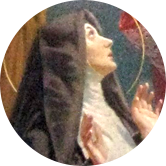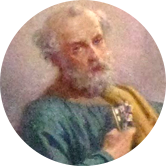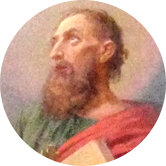
Margaret was born on Monday, July 22, 1647 in L'Hautecour in the Burgundy region of France and was the fifth child of Claude Alacoque and Philiberte Lamyne. She was baptized two days later.
At the age of four she was entrusted to the care of her godmother and went to live with her in the castle of Courchevel. On December 11, 1655, her father died when he was only forty years old. Margaret returned to her family but enrolled in a college run by the Poor Clares in Charolles where she received her First Communion. She went on to remain with the Poor Clares for only two more years, becoming so seriously ill that she couldn’t even walk. After a special vow to the Blessed Virgin Mary on her behalf, Margaret was miraculously cured. She wrote, "Since there was no remedy for my illness, my parents made a vow to the Holy Virgin promising that if she healed me, I would one day become one of her daughters. I had just pronounced the vow when I was immediately healed ... "(A.6).
In what was a difficult period for her whole family, Margaret learned to accept her sufferings with fortitude, keeping an image of the Crucified Jesus fixed before her and remaining absorbed in prayer before the Blessed Sacrament. In 1669, when she was 22,she was confirmed, adding "Mary" to her name, and on June 20, 1671, at the age of 24, she entered the Visitation monastery of Paray-le-Monial.
On November 6, 1672, Margaret Mary professed her vows and became a nun. December 27, 1673 marked the beginning of a new period of life as a religious for Sr. Margaret Mary in the Visitation monastery, a time characterized by special mystical gifts: three revelations in which Jesus revealed his heart to her. These revelations were the cause of much suffering and misunderstanding between Sr. Margaret Mary and her superior who was fearful that this was all the result of the young nun’s imagination since she was often led in extraordinary ways.
During this time, Sr. Margaret Mary’s sole comfort and support was Father Claude de la Colombière who, after listening to her, understood that she was a chosen soul. The priest encouraged her, reassuring her as to the origin of her visions and inviting her to humbly receive what the Lord ordained for her, always in an attitude of obedience and thanksgiving.
The three revelations(or apparitions):
After this second revelation the Sacred Heart asked St. Margaret Mary: "First of all, you will receive me in Communion every time that obedience will allow you, even if you will be mortified and humiliated, accepting it as a pledge of my Love. You will also receive Communion on the First Friday of each month. He asked her to offer adoration from 11 o’clock until midnight between Thursday and Friday so as to participate in the Lord’s agony in the Garden of Olives. Of the third revelation, known as the great revelation, which she received during the Octave of Corpus Christi, St. Margaret Mary wrote "Jesus, baring his Heart, said to me: “Behold the Heart which has so loved men that it has spared nothing, even to exhausting and consuming Itself, in order to testify to Its love; and in return, I receive from the greater part only ingratitude, by their irreverence and sacrilege, and by the coldness and contempt they have for Me in this Sacrament of Love. But what I feel most keenly is that it is hearts which are consecrated to Me, that treat Me thus. Therefore, I ask of you that the Friday after the Octave of Corpus Christi be set apart for a special Feast to honor My Heart, by communicating on that day, and making reparation by a solemn act, in order to make amends for the indignities which It has received during the time It has been exposed on the altar. I promise you that My Heart shall expand Itself to shed in abundance the influence of Its Divine Love upon those who shall thus honor It, and cause It to be honored."
Soon devotion to the Sacred Heart spread among the Christians. Margaret Mary died at the age of 43.

Simon, originally from Bethsaida, in Galilee, near the lake of Genezareth, also known as the Sea of Tiberias, was the son of Jonah. A fisherman by trade, he owned some small fishing boats together with his brother Andrew and James and John. During the off season for fishing, his brother Andrew met Jesus and remarked to Peter about the "Messiah".
Simon wished to know Jesus. Jesus saw in Peter an obedient man who was also impulsive, enthusiastic, truthful, upright and generous. Jesus chose him as one of his elect: "You will be called Peter.” From that moment, Simon was no longer a fisherman of fish, but of men. Peter denied Jesus three times, but many times professed his faith in him. "Lord, to whom shall we go? You have the words of eternal life!” "You are the Christ, the son of the living God." "Lord, You know that I love you". Peter is the first of the apostles and was present at the wedding at Cana. It was he who with John was commissioned to prepare the upper room for the feast of Passover.
When Jesus was arrested, only Peter and John followed him. However, when he was recognized as one of the disciples, he denied knowing Jesus. He wept and repented for having denied Jesus. A few days before the ascension Jesus asked him: "Peter, do you love me?" After Peter's “Yes”, Jesus’ words "Feed my lambs" confirmed Peter as head of the Church, entrusting the care of the whole flock to him. In 64 AD, Peter was placed in prison and was condemned to die by crucifixion. He managed to convince his torturers to crucify him upside down, out of his conviction that he wasn’t worthy to be treated like his Divine Master. On June 29 we celebrate the Solemnity of Saints Peter and Paul.

The figure of Paul is important for the Church for the broad scope of his apostolic activity and for his "conversion" from being a persecutor of Christians to a zealous Apostle of the Gentiles. Paul's conversion is celebrated in the Church on January 25.
Saul, his given name prior to his conversion, was born in the city of Tarsus, a major commercial hub and cultural center in ancient civilization. His father was a Pharisee and a descendant of Jews, from the tribe of Benjamin. Because of their loyalty shown to the emperor, Saul’s family received Roman citizenship.
Therefore Saul was a Roman citizen and also a Pharisee of noble origin. He was wealthy, religious, intelligent, studious and cultured. When he was 15 he went to Jerusalem to continue his studies of Latin, Greek and Hebrew in the famed school of Gamaliel. His parents aspired that he should become a well-respected rabbi.
Saul was a persecutor of the Christians, yet God had a special plan set aside for him. In the Acts of the Apostles (Acts 9: 1,9) his encounter with Jesus appeared as a dazzling light. Not only did this meeting with Jesus change his name to Paul, it would so change his life and heart that he would become one of the greatest pillars of the Christian faith, the most zealous propagator of faith in Jesus Christ.
He was baptized by Ananias, a Christian from Damascus. From there he left to announce the word of God as Jesus had commissioned him. Paul traveled extensively in his evangelizing activity and many were converted to the faith. He was persecuted, arrested several times, and suffered greatly. He won the palm of martyrdom in the year 67 in Rome.